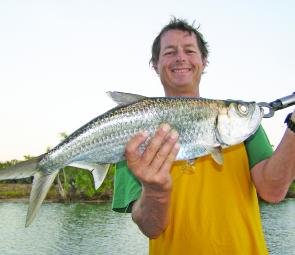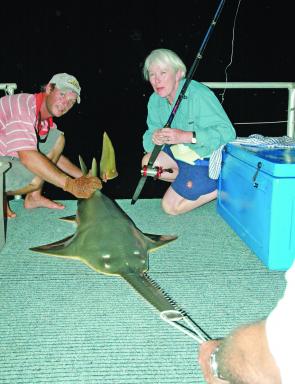May, June and July are perhaps the most majestic times to be stationed in the far north. Everything is lush and green and you can completely forget about the searing heat and brown-baked state of things come the end of the dry season.
May is often a transition month between the wet and dry seasons, and is also when the easterly trade winds keep conditions perfect along inshore regions of the eastern Gulf.
May will hopefully be the month barramundi re-establish themselves in more angler-friendly locations and the estuaries clean up enough for lure casters to get back in on the action. Past experience has shown a slowly receding tide will be best at this time of year.
Quite often, fishers pass by very good-looking barra country to cast lure after lure at snag piles. May is a great time of year to broaden your horizons, because many productive snags and structure will still be covered by the higher water levels. Look for indentations in the main bank, preferably with a small back-eddy in around 2-4ft of water.
Start by aiming your casts at the outside edge of these small inlets, concentrating on protruding structure and back-eddies. Then, throw a couple of casts to the back, searching for spots where bait is congregating. Another good ploy is to look for spots where small drains funnel out at low tide, underneath a dense mangrove line. Return on an outgoing, mid-tide, flicking shallow running lures in tight to the mangrove line. Tighten your drag an extra notch!
Water temperatures should still be fairly high and in 2006 we enjoyed great barra fishing through May and well into June. With plenty of water still pumping out of the creeks and rivers up this way, upstream rock-bars will be a good option for anglers fishing with bait and lures. Focus your efforts on the pressure points (in front of the spots water flows past structure), using lightly weighted dead-baits. Mangrove jack, fingermark, big grunter and bream will all take a range of dead baits.
Look for tarpon tailing around dusk in deeper stretches or spots with strong current. Cast small flashy flies, tiny poppers and soft-plastics resembling prawns. These fish are tricky to hook and even more difficult to land. Saratoga also fit in this basket and will be feeding actively in May. These fish may be found for a short time, in the downstream and brackish areas of systems adjacent to wetland areas.
A current line often marks two contrasting pieces of water. They are a good sign of depth, structure and direction of tidal movement. It is crucial this time of year to identify what these current lines are telling you and where fish may be feeding in and around them.
You might find huge queenfish patrolling the outer edge of the dirty-water line beyond the mouth, or you may find barra ambushing bait as it is pushed out of a tiny run-off into the main river. Be prepared to cover a few miles and work the tides over and above the key times of dawn and dusk.
Reads: 933
May is a good time to look for tarpon tailing around dusk in deeper stretches or spots with strong current.

Anglers fishing in the Archer River might be lucky enough to come across a sawshark like this one that was landed recently.




